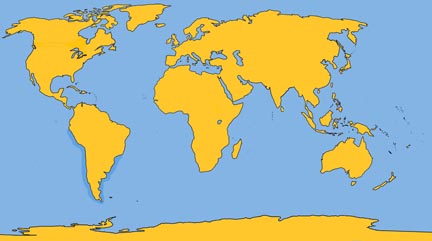Family: Phocoenidae
Genus: Phocoena
Species: P. spinipinnis Burmeister, 1865
Burmeister’s porpoise is one of two members of the genus Phocoena that lives in the Southern Hemisphere, the other being the spectacled porpoise. Burmeister’s porpoise is considered to be the most abundant coastal small cetacean in South American waters, and is thought to be distributed in both the Atlantic and Pacific oceans. It’s most striking feature is the shape and position of the dorsal fin, which is triangular but very low and pointed to the rear so that it appears as a continuation of a dorsal ridge.
Physical Description: The body is stocky with a slight indentation at the blowhole. A sharp, well-defined ridge extends from the rear of the dorsal fin to the flukes.
Color: They are almost completely dark, with a nearly white genital region, and some white on the chin from the tip of the lower jaw, spreading to and dissolving at the anterior ridges of the flippers.
Fins and Flukes: The dorsal fin begins well to the rear of the mid-back region and follows the dorsal ridge out until it curves down and in toward the body to resemble a triangular fin slanted sharply to the rear. About half a dozen small tubercles are located on the leading edge of the dorsal fin. The flippers are paddle-shaped and rounded at the tips. The flukes are well developed, slightly rounded at their tips, with a definite median notch.
Length and Weight: This porpoise reaches at least 6.25 ft (1.9 m) and an estimated weight of 150 to 160 lb (68 to 73 kg).
Teeth: There are 14 to 16 teeth in each side of the upper jaw; 17 to 19 in each side of the lower jaw.
Feeding: They are known to feed on squid.
Breathing and Diving: No information available.
Mating and Breeding: A 1.5 ft (46 cm) fetus was collected in Uruguayan waters in late February or early March.
Herding: In most sightings so far, about a dozen or fewer animals appeared swimming together.
Distribution: They are found in the shallow waters of both coasts of South America — east coast of South America from Uruguay to Patagonia, Argentina; west coast from Paita, Peru, to Valdivia, Chile. Apparently these are two distinct stocks, one in the Atlantic, and one in the Pacific.
Migration: No information available.








